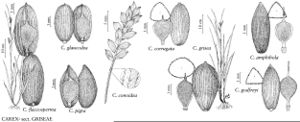Carex flaccosperma
Amer. J. Sci. Arts, ser. 2, 2: 245. 1846.
Plants densely cespitose; rhizome internodes 1.2–2.8 mm thick. Culms yellowbrown at base, 10–60 (–75) cm. Leaves: sheaths glabrous; blades glaucous, widest blades 6.3–14.7 mm wide, smooth abaxially or sparsely antrorsely scaberulous on main veins. Inflorescences 0.40–1 of culm height; peduncles of lateral spikes smooth; peduncles of terminal spikes 0.7–20 (–51) mm, barely to much exceeding lateral spikes; proximal bract sheath loose, abaxially glabrous, sheath front apex truncate; ligules (3–) 4.7–9 mm; distal bract slightly shorter than to much exceeding terminal spike. Spikes 4–6, distal 2–4 overlapping; lateral spikes pistillate, with 12–39 perigynia, 11–41 × (5–) 5.7–8 (–9.6) mm, ratio of spike length (in mm) to flower number = (0.86–) 1–1.3 (–1.6); terminal spikes 6–34 × 1–3.2 mm. Pistillate scales 1.9–2.8 (–3.1) × (1.5–) 1.7–2.4 mm, margins whitish, entire, apex awnless or with awn to 0.6 (–1.6) mm. Staminate scales 3.8–5.3 1–1.8 mm. Anthers 1.6–2 mm. Perigynia spirally imbricate, 44–57-veined, unwrinkled, oblong-ovoid, (4–) 4.2–5.5 (–6) × (1.5–) 1.7–2.4 mm, (2–) 2.2–2.8 (–3.1) times as long as wide, obtusely triangular in cross-section, dull, base very gradually tapered, apex gradually tapered; beak absent or straight, 0–0.3 mm. Achenes obovoid, 2.5–3.4 × (1.3–) 1.4–1.6 (–1.7) mm, 0.37–0.5 times as long as perigynia, loosely enveloped by perigynia; stipe straight, (0.2–) 0.3–0.5 (–0.6) mm; beak straight or bent less than 30°, (0.1–) 0.2–0.4 (–0.5) mm.
Phenology: Fruiting spring.
Habitat: Wet-mesic deciduous forests, usually in acidic loams low in calcium, on flood plains and in swamps
Elevation: 0–200 m
Distribution

Ala., Ark., Fla., Ga., Kans., Ky., La., Miss., Mo., N.C., Okla., S.C., Tenn., Tex., Va.
Discussion
Carex flaccosperma is frequent, especially on the Coastal Plain west of Alabama. It grows frequently with C. caroliniana, C. corrugata, and C. crus-corvi and occurs occasionally with C. glaucodea. When C. flaccosperma and C. glaucodea co-occur, C. flaccosperma usually inhabits slightly wetter soils than C. glaucodea. Natural hybrids between C. flaccosperma and C. glaucodea form rarely and are sterile (R. F. C. Naczi 1991). Hybrids have been collected in Arkansas, Louisiana, Missouri, and Oklahoma.
Selected References
None.
Lower Taxa
No values specified."shortened" is not a number.
